They say that the eyes are the window to the soul, but many of us probably would prefer not to stare deep into the eyes of a snake. However, you’d be surprised by just how stunning snake eyes can be. In fact, snakes have surprisingly expressive eyes that can reveal a lot about each animal. Some snakes have vertical or elliptical pupils that help them to see in the dark, while others might be yellow, red, green, and on very rare occasions, even blue! Let’s take a closer look at 15 snakes with the most stunning eyes in the world!
1. Green Tree Python (Morelia viridis)
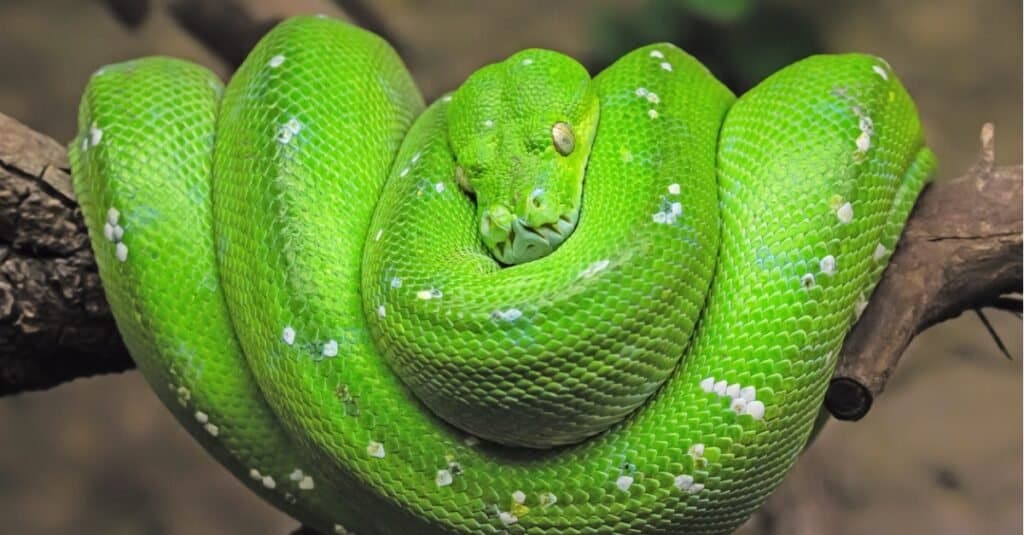
The Green tree
python
(Morelia viridis) snake, native to New Guinea and Indonesia. Green tree pythons have over 100 long, sharp, backward-pointing teeth designed to bite into prey and hang on.
©iStock.com/tane-mahuta
Not only do green tree pythons stand out with their brightly colored bodies, but they also have some of the most stunning eyes in the world. These unique snakes have bright green and somewhat slender bodies that grow around 6.5 feet long on average. They have distinct, angular heads that are clearly defined from their necks, giving them a regal and sophisticated profile. Their eyes are large and prominent, with shades of green and greenish yellow swirls and a vertical black pupil.
2. Blue-Eyed Leucistic Python (Python regius)
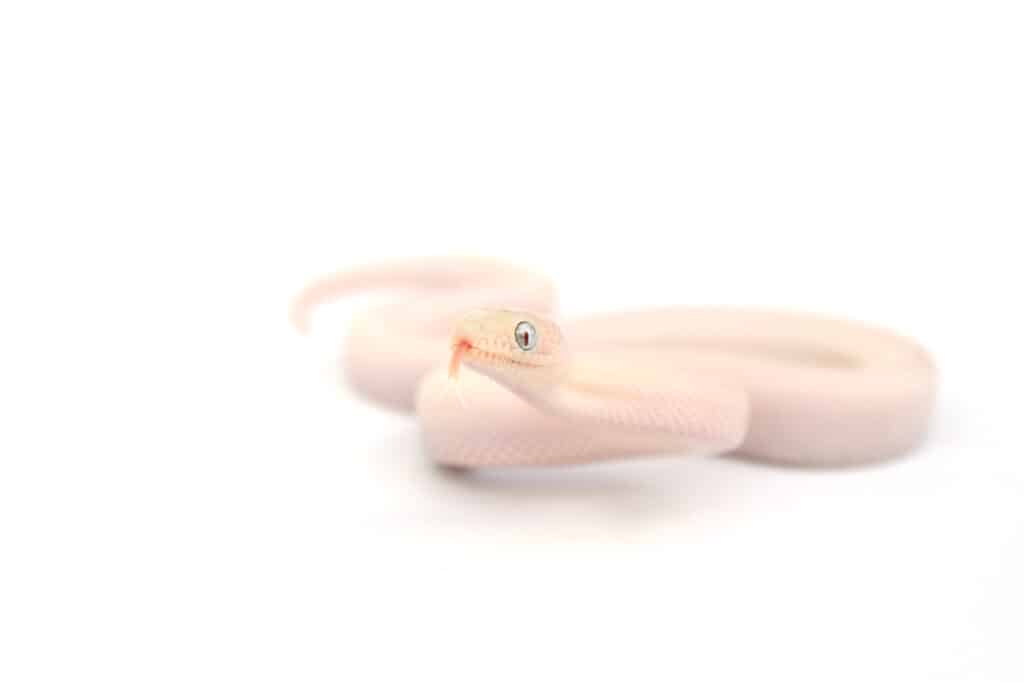
Blue Eyed Leucistic (Lucy)
Ball Pythons are not albino
.
©iStock.com/mikeschultzphotos
One of the most sought-after python color morphs in the pet world is the “Blue-Eyed Lucy”, or Blue-Eyed Leucistic Python. A blue-eyed Lucy is a very specifically bred ball python with a beautiful snowy white body. Unlike albino snakes, however, blue-eyed Lucy snakes have piercing crystal blue eyes, rather than red ones.
You won’t find a blue-eyed lucy in the wild, as these snakes are very difficult to breed, but the result is phenomenal. Ball pythons grow up to 72 inches and are famous for their tendency to curl their body into a ball when they feel threatened.
3. Large-Eyed Green Tree Snake (Rhamnophis aethiopissa)
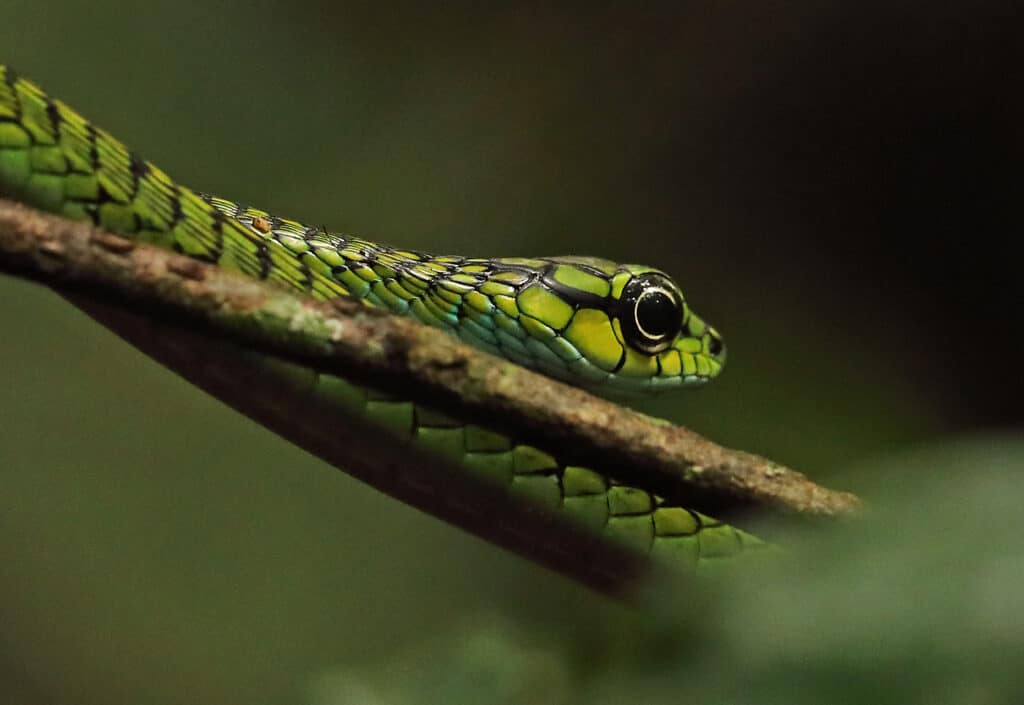
The venomous Large-eyed Green Tree Snake (Rhamnophis aethiopissa) lives in
Africa
.
©iStock.com/neil bowman
Another fabulous green snake on this list is the large-eyed green tree Snake. These venomous snakes live in Africa, although not a lot is known about their venom. Large-eyed green tree snakes grow up to 5 feet long at most and have smooth scales covering their slender bodies. The scales on their backs are green to yellowish green with stark black outlines.
However, it is the snakes’ eyes that really stand out. Large-eyed green tree snakes have enormous round eyes that seem to bug out of their small sized heads. Their eyes are especially stunning when the snake inflates its throat like a cobra!
4. Boomslang Snake (Dispholidus typus)
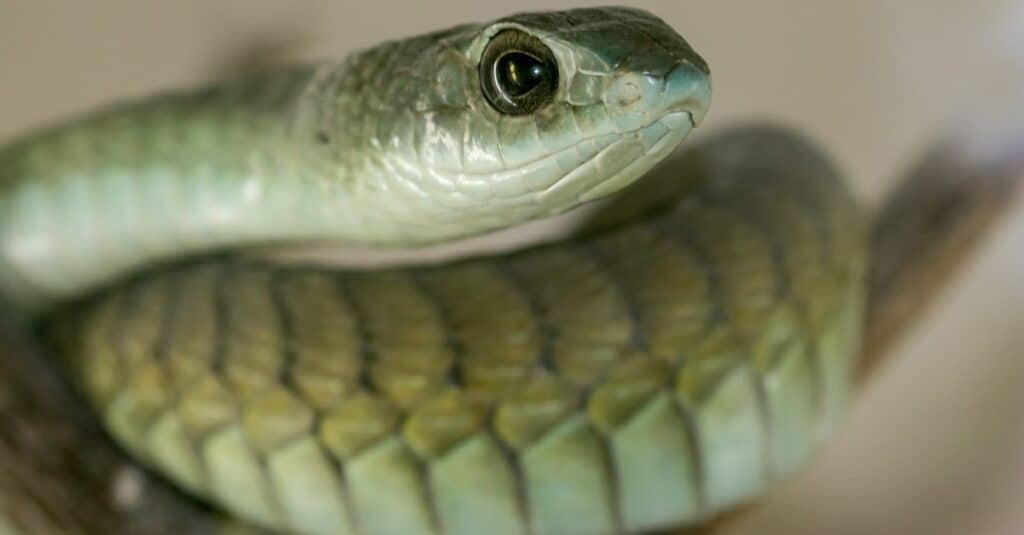
Boomslangs have a long, slender body with an egg-shaped head.
©iStock.com/Ken Griffiths
The exceptionally large eyes of the boomslang snake are hard to miss. As you can probably guess, this African snake has great eyesight, especially with its unusually large and round pupils. Its excellent eyesight comes in handy when this venomous snake climbs through the trees hunting frogs, lizards, and chameleons. Don’t worry thought, although it is venomous, the boomslang snake is not harmful to humans due to its small fangs and small venom glands.
Boomslang snakes usually grow between 3-5 feet in length, although some grow longer than 6 feet. Female snakes are brown, while males are usually light green with yellowish bellies, and their scales have blue or black edges.
5. Synophis zaheri
The next snake with the most stunning eyes in the world was only recently discovered, so it does not yet have a common name. The Synophis zaheri is a nonvenomous fishing snake that lives in southwestern Ecuador. It has a slender body and distinct head, but only grows around 14 inches long.
This snake may seem dull at first with its grayish brown body, but its scales have a uniquely iridescent sheen to them, and how about those eyes! The snake’s eyes are so large that they take up over 1/3 of its head! What’s really unique about those bulbous eyes, however, is that they are almost entirely black. In fact, this is one of the only snakes in the entire world that has black eyes!
6. Rough-Scaled Bush Viper (Atheris hispida)
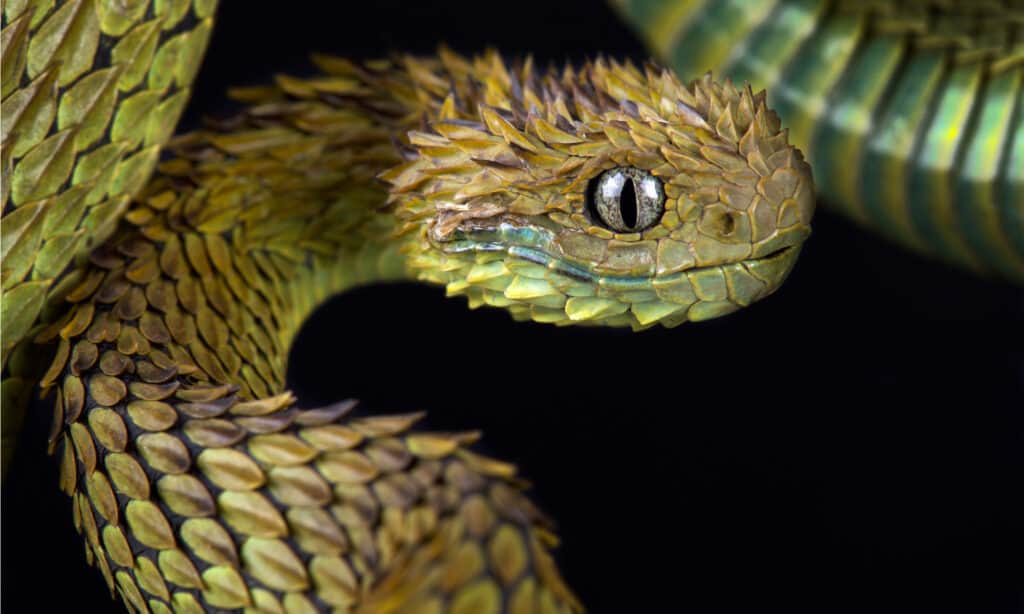
Bush
Vipers
like to sit in the ends of clusters of leaves and flowers, waiting for their next meal.
©reptiles4all/Shutterstock.com
Although it is famous for its incredibly keeled and prickly scales, the rough-scaled bush viper also has a set of stunning eyes! With its large head and short snout, the snake’s rounded eyes and elliptical cat-like pupils really stand out, particularly in contrast to its vividly colored, bristly scales, making it look like some type of small, mystical dragon. Rough-scaled vipers are endemic to Central Africa and grow up to 29 inches at the most. Their venom is a complex mix of both neurotoxins and cytotoxins, which means that this is one baby dragon you do not want to mess with.
7. Egyptian Saw-Scaled Viper (Echis pyramidum)
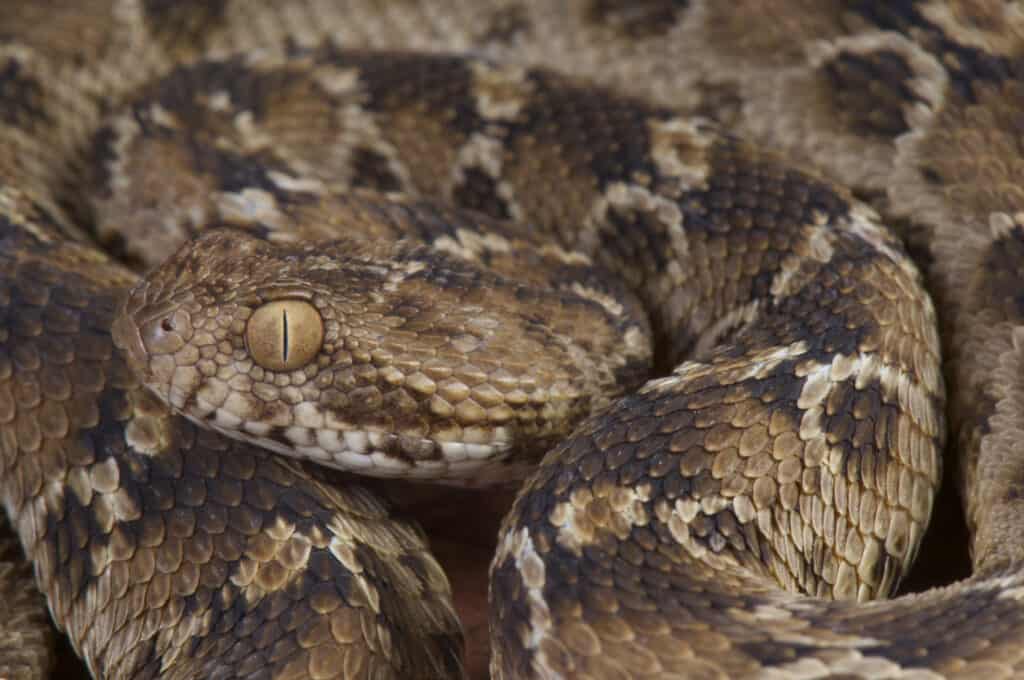
The Egyptian
saw-scaled viper
is a highly venomous snake species responsible for many snakebites across its range.
©iStock.com/reptiles4all
Found in the Arabian Peninsula and northeastern Africa, the Egyptian saw-scaled viper (sometimes called the northeast African carpet viper) is one of the snakes known for causing the most snakebite deaths in the world. This stunning-eyed snake is formidable to say the least, although it is not very large, growing only 12-24 inches in length. Its body is covered by keeled scales, and it has a short and wide head shaped like a rounded triangle.
Egyptian saw-scaled vipers live in dry areas like deserts and savannas, and their coloring helps them to camouflage with beautiful and complex patterns of tan, brown, and cream. These snakes also have very stunning eyes. Their large eyes glitter in the sun with gold and bronze iridescent coloring. I wouldn’t get too close to these beautiful snakes, however, as they are venomous and extremely irritable. In fact, Egyptian saw-scaled vipers are nervous snakes that will aggressively strike and bite quickly and repeatedly, so its best to admire them from a distance.
8. Sahara Sand Viper (Cerastes vipera)

The color of the sand
viper helps it to blend in with its habitat where it hunts
for prey.
©reptiles4all/Shutterstock.com
This beautiful desert snake is a venomous viper found in the Sinai Peninsula and northern Africa. It’s a surprisingly small snake, growing only 8-14 inches, but what it lacks in size it makes up for in appearance and stealth. Sahara sand vipers slither gracefully through the sand, hiding easily with their sand-colored bodies and roughly keeled scales. Although their round eyes are not as large as many of the snakes on this list, their glittery golden color makes them some of the most stunning snake eyes in the world.
9. Schokari Sand Racer (Psammophis schokari)

The Schokar Sand Racer (
Psammophis schokari) lives in Asia and Africa.
©iStock.com/slowmotiongli
Some of the most unique eyes belong to the Schokari sand racer in Asia and Africa. Its body is thin and long like a garter snake, with lines of tiny, closely spaced spots or bold stripes running down its length. The snake’s eyes have a unique two-toned pattern, with a darker bronze-colored outer ring, and a lighter gold inner ring, in addition to its large round pupil. When basking in the sun, they almost look like a glowing fire!
10. Banded Cat-Eyed Snake (Leptodeira annulate)
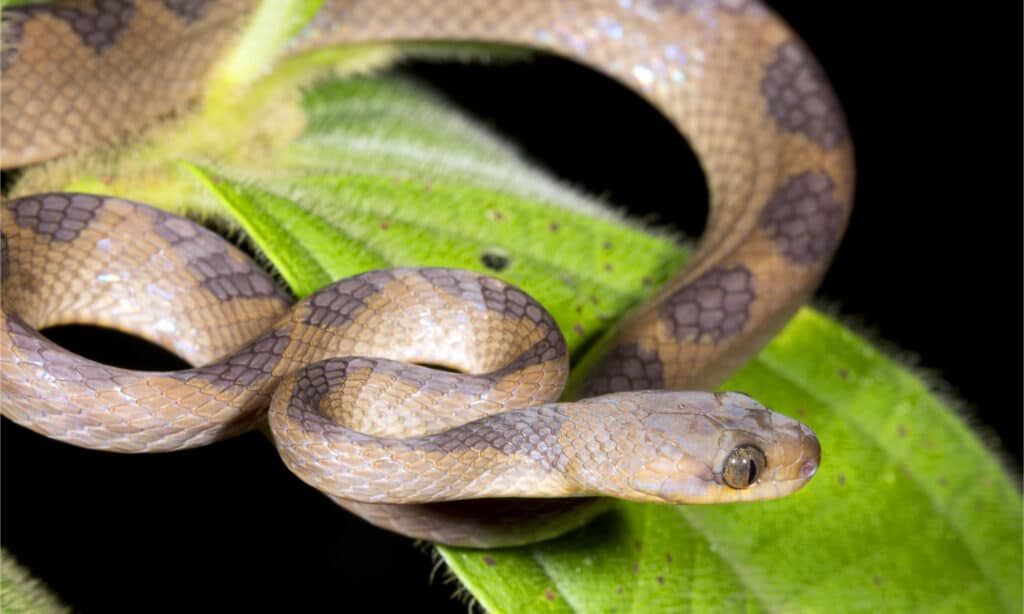
Cat-Eyed Snakes have large dark markings or saddle shapes along the back
©Dr Morley Read/Shutterstock.com
Another snake with the most stunning eyes in the world is the banded cat-eyed snake, or cat-eyed night snake. This slender snake grows up to 30 inches long with yellow or brown scales and large, distinct dark spots undulating down its back. The snake’s glittery eyes look almost too large for its head, and some have thin black rims that make them look like they are wearing spectacles. Banded cat-eyed snakes live in Mexico, South America, and Central America, usually in moist forests or along their edges.
11. Moila Snake or False Cobra (Rhageris moilensis)
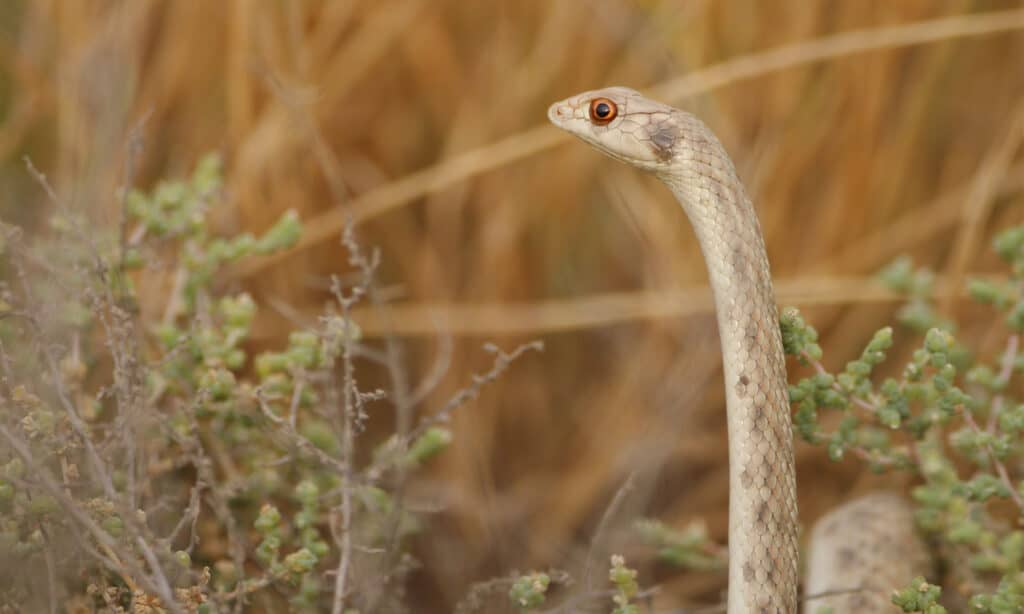
When false cobras feel threatened, they mimic a cobra as a defense.
©iStock.com/Abdelrahman M Hassanein
Although the Moila snake is not an actual cobra, it is often called a “False Cobra”. When this snake is threatened, it spreads its hooded neck out wide and hisses loudly, just like a real cobra. However, when the snake is calm, its head is small and round. False cobras grow around 5 feet on average and eat lizards and rodents in the Middle East and Africa.
Their bodies are tan or yellow with darker blotches or thick crossbands, and there is a darker stripe that runs along each side of the snake’s head and across its snout. Sometimes with the snake’s large black pupil, it looks like the stripe runs straight through the snake’s eye! The eyes themselves are dark bronze, with a large black pupil surrounded by a sliver of yellow, which makes them look like they are glowing!
12. Ruby-Eyed Green Pit Viper (Trimeresurus rubeus)
Recently discovered in Cat Tien National Park in Vietnam, the ruby-eyed green pit viper is a new snake species with absolutely stunning eyes. Like its name, this snake has striking ruby-red eyes, which really pop in contrast to the vivid green and yellow green of its body. The end of its tail is also red, matching its stunning ruby eyes. We still don’t know a ton about ruby-eyed green pit vipers, since they have only been seen at night so far, usually hiding within thick bushes and vegetation. The IUCN Red List categorizes these eye-catching snakes as threatened or vulnerable.
13. Diademed Sand Snake (Lythorrynchus diadema)
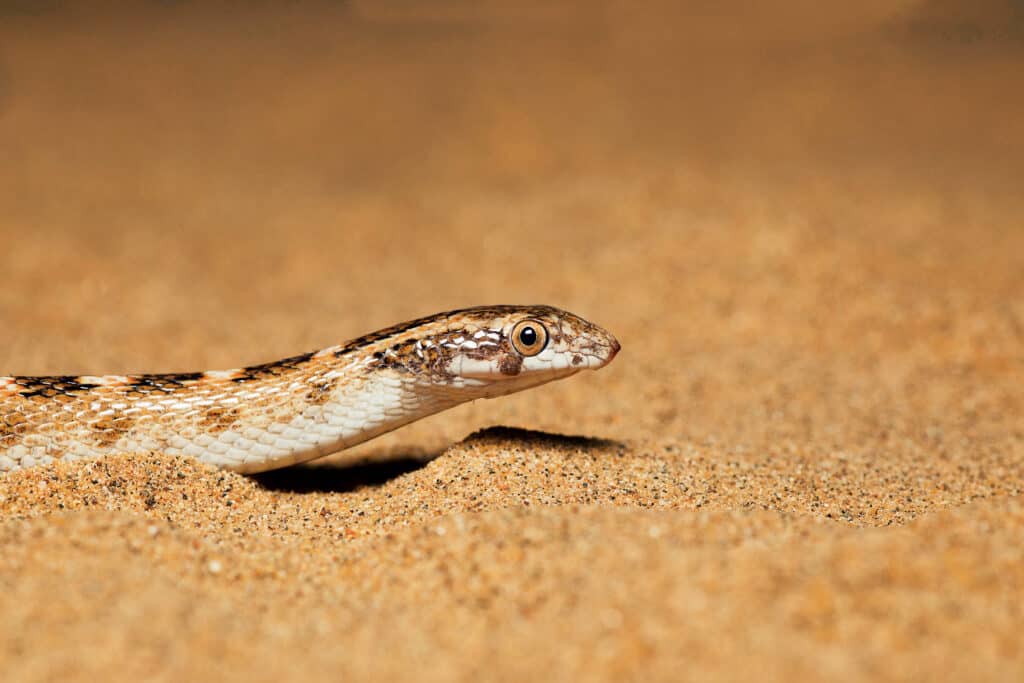
The Awl Headed Snake (
Lytorhynchus diadema), using its blunt snout to dig through the sand.
©iStock.com/ePhotocorp
Also called the awl-headed snake and the crowned leafnose snake, the diademed sand snake lives in the sandy and dry regions of western Asia, northern Africa, and the Middle East. It grows between 12-20 inches in length, and usually has a pale, cream, orange, or reddish-brown body covered in dark, rhomboid-shaped spots. Its eyes contain various shades of golden orange like a swirling fire, with dark rims and round pupils. Diademed sand snakes have oval heads and blunt noses to help them burrow through the sand and pop up when it is least expected as they hunt for lizards.
14. Blunthead Tree Snake (Imantodes cenchoa)
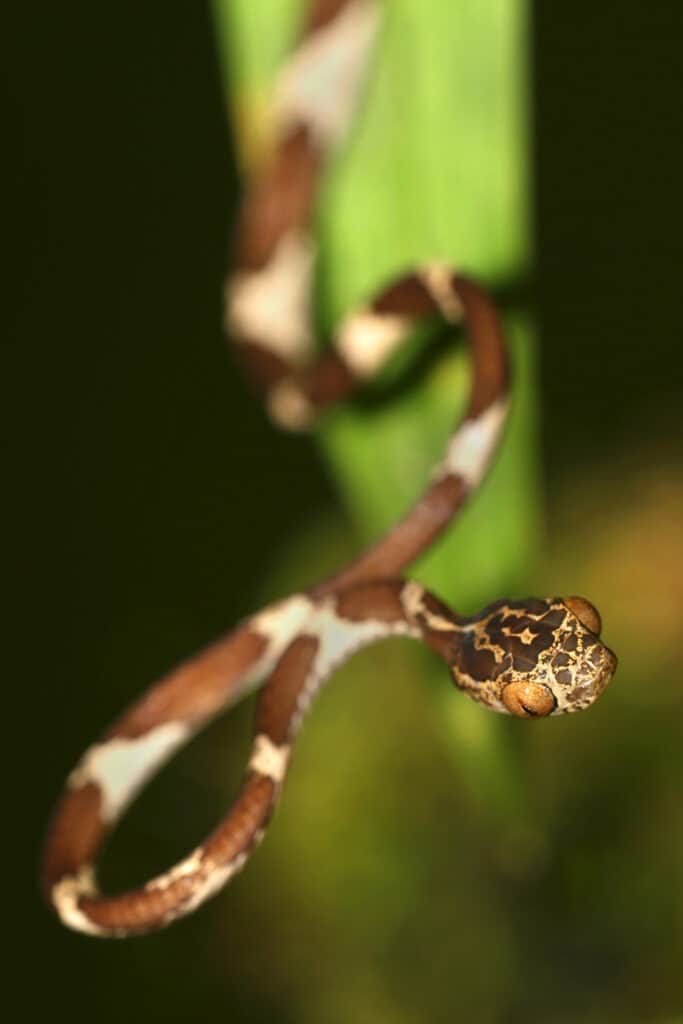
The goofy eyes of the Blunthead Tree Snake (Imantodes cenchoa) help it to see in the dark, straight ahead, and down.
©iStock.com/Alberto Carrera
In truth, the bluntheaded tree snake may not make it on the list of “Most Beautiful Snakes in the World,” but there is no doubt that this snake has some of the most stunning and unique eyes in the world! Blunthead tree snakes have slender, long bodies that typically grow 31-35 inches long, capped off with surprisingly thin neck and a short and stubby head.
Of course, it is the snake’s large and bulbous eyes that steal the show, taking up at least ¼ of its entire head! Blunthead tree snakes may look a bit goofy, but their enormous and strategically placed eyes allow them to look down (rather than only straight ahead like many other snakes), and they can see extremely well in the dark.
15. Montpellier Snake (Malpolon monspessulanus)

Although it looks incredibly fierce, the Montpellier Snake has a very non-threatening nature.
©iStock.com/AngeloDeVal
The last on our list of snakes with the most stunning eyes in the world is the Montpellier snake. Found along the southern Mediterranean Coast of France, as well as in northwestern Africa, Portugal, and Spain, the Montpellier snake grows up to 7 feet long and eats lizards. It has smooth but defined scales along its strong body, with variegated colors ranging from brown to yellow, yellow-green, and dark green.
The snake’s head has a unique shape, however, with sharp angles and long ridges, particularly over its eyes, that make the snake look extremely fierce and formidable. Its eyes are dark, with a stark and glowing, orange-colored ring surrounding each large, round pupil, which only adds to its fierce appearance.
Each eye almost looks like the Eye of Sauron from Lord of the Rings! Unfortunately, its appearance causes fear in many people, who commonly persecute this snake even though it is not really dangerous to humans.
Summary of the 15 Snakes With the Most Stunning Eyes
Here is a list of the 15 Snakes With the Most Stunning Eyes in the World:
| Rank | Snakes |
|---|---|
| 1 | Green Tree Python |
| 2 | Blue-Eyed Leucistic Python |
| 3 | Large-Eyed Green Tree Snake |
| 4 | Boomslang Snake |
| 5 | Synophis zaheri |
| 6 | Rough-Scaled Bush Viper |
| 7 | Egyptian Saw-Scaled Viper |
| 8 | Sahara Sand Viper |
| 9 | Schokari Sand Racer |
| 10 | Banded Cat-Eyed Snake |
| 11 | Moila Snake or False Cobra |
| 12 | Ruby-Eyed Green Pit Viper |
| 13 | Diademed Sand Snake |
| 14 | Blunthead Tree Snake |
| 15 | Montpellier Snake |
The photo featured at the top of this post is © iStock.com/Ken Griffiths
Discover the "Monster" Snake 5X Bigger than an Anaconda
Every day A-Z Animals sends out some of the most incredible facts in the world from our free newsletter. Want to discover the 10 most beautiful snakes in the world, a "snake island" where you're never more than 3 feet from danger, or a "monster" snake 5X larger than an anaconda? Then sign up right now and you'll start receiving our daily newsletter absolutely free.
Sources
- Thai National Parks, Available here: https://www.thainationalparks.com/species/trimeresurus-macrops
- Morocco Herps, Available here: http://www.moroccoherps.com/en/ficha/Cerastes_vipera/
- Clinical Toxinology Resources, Available here: http://www.toxinology.com/fusebox.cfm?fuseaction=main.snakes.display&id=SN0222
- The Reptile Database, Available here: https://reptile-database.reptarium.cz/species?genus=Echis&species=pyramidum
- A-Z Animals, Available here: https://a-z-animals.com/blog/10-snakes-with-the-biggest-eyes-in-the-world/
- A-Z Animals, Available here: https://a-z-animals.com/blog/these-2-snakes-have-absolutely-gorgeous-blue-eyes/
- Morocco Herps, Available here: http://www.moroccoherps.com/en/ficha/Lytorhynchus_diadema/
- Zootaxa, Available here: https://www.biotaxa.org/Zootaxa/article/view/zootaxa.2757.1.1
- Morocco Herps, Available here: http://www.moroccoherps.com/en/ficha/Malpolon_monspessulanus/
Thank you for reading! Have some feedback for us? Contact the AZ Animals editorial team.






